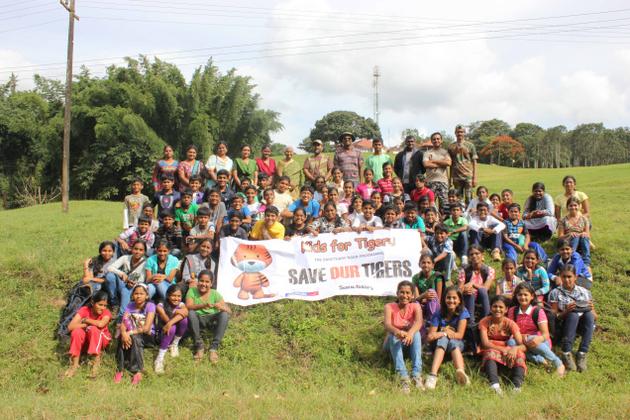
They did not spot a tiger, but the school children who visited Top Slip learnt important lessons about protection and well being of forests and the environment. The writer learnt a few lessons to0.
A loud scream splits the air, and it is followed immediately by more screams. Every one rushes out, fearing the worst. It is a dark night at Top Slip, and 67 kids have just left the dining room making place for the grown-ups to eat. Earlier that day, they visited the Kolikamuthi elephant camp to watch the animals being fed and tended to by the local tribals. And conversations had mostly revolved around rogue elephants, angry bears, gaur and, of course, tigers. Had the kids been attacked by a wild animal?
Thankfully not. We catch a glimpse of a disappearing snake, but not before it is identified as non-venomous. There is no harm done. What follows, right there under the starry sky is an impromptu lesson by Mohammad Saleem on snakes, and the kids listen, engrossed. Class VII and VIII students of Subbaiah Central School, Tirupur, have come to Top Slip with their teachers on a programme called ‘Kids for Tigers’ initiated by Sanctuary Asia.
The importance of green
Saleem is the co-ordinator for Sanctuary Asia in Coimbatore, and he has organised the outing to sensitise the children on the importance of the environment. “Thousands of children like you are enrolled in the project,” explains Saleem who is also the founder and managing trustee of the Environment Conservation Group. “From Kashmir to Kanyakumari, a movement is on to spread awareness about the tiger. We are doing this for you, it is your world. You should know the importance of forest cover, for the world to survive,” he says.
But, why only the tiger? There are so many other animals too that live in the forest… don’t they deserve to be saved?
“The tiger indicates the health of the forest. Its survival ensures ecological balance. It ensures a healthy prey base and greenery and protects our water source. A healthy tiger population means a healthy environment. Saleem shares some horrifying statistics. In the 1900s there were around a lakh tigers in the world. Now the population has shrunk to a mere 3,000-odd tigers. And, of those, India has 1,706 (according to the 2012 census).
The two-day trip accomplishes a year’s worth of teaching in class, say the school teachers. And, indeed, as the kids take a guided walk into the jungle (cut down to a manageable three km) they pick up a wealth of knowledge from Saleem and his team made up of G. Srinivasan, M. Hasan, A.R. Ameen and M. Natraj. The conservationists tell the children how to observe Nature closely, how a small patch of the jungle teems with life. Even a dead tree trunk is home to thousands of insects and worms. Everything sustains everything else. Everything needs everything else to survive.
Children are taught to identify the birdcalls. Soon they know what a barbet sounds like and how a babbler calls out. They listen to the woodpecker knocking. They encounter spiders in their massive webs and millipedes that curl up when touched. A puddle of water in a rocky clearing yields a baby snake, tadpoles and scores of insects. Then, Saleem picks up what looks like a small piece of jagged wood. “What is this,” he asks. It is part of a deer antler that is source of food for porcupines as it is rich in calcium; porcupines need calcium for their quills… The walk is peppered with information and facts and the kids soak it all in.
At the end of the trek, we compare notes. We spotted the vernal hanging parrot, scarlet minivet, spotted dove, red vented bulbul, peafowls, jungle babblers and the flame back woodpecker. We heard the great pied hornbill and grey jungle fowl. And, in the dense canopy of trees we caught a glimpse of the gaur, Malabar giant squirrel, sambar and spotted deer, besides the Nilgiri langur and the common langur.
We did not see any tigers, but we could feel its presence keeping an eye on the health of the forest!
Facts
The tiger population which was around 1,00,000 in 1900s had dropped now to less than 3,500 in the wild. Before Independence there were around 40,000 tigers in India. Today the number stands at 1,706, which makes India home to more than half of the world’s tiger population.
‘Kids for Tigers’ is a national environmental educational programme aimed at spreading awareness among students on the importance of saving forests. It uses tiger as a metaphor for all of Nature. The programme covers thousands of students from more than 750 schools across 15 cities and towns in India. The programme is implemented by Sanctuary Asia and supported by Aircel.
source: http://www.thehindu.com / The Hindu / Home> S&T> Environment / by Pankaja Srinivasan / Coimbatore – September 01st, 2013